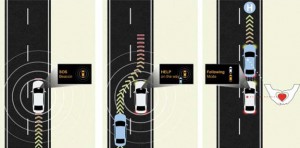While it hasn’t announced a production date, Honda is getting ready to join the autonomous driving revolution, revealing a prototype of its Acura RLX sedan capable of hands-off highway driving.
The Japanese maker has also developed a new “virtual tow” system that it says a motorist could use to assist another vehicle in distress.
Frank Paluch, president of Honda R&D Americas Inc. said the Japanese automaker one of many working towards of a collision-free society by utilizing innovations in active safety, connected and automated vehicle technology.
“The pursuit of a collision-free society is part of Honda’s global safety concept of ‘Safety for Everyone’ and the company’s efforts to use technology to provide enhanced protection for automobile occupants, motorcycle riders, pedestrians and other road users,” he explained.
Several manufacturers have set hard timetables for introducing their autonomous systems. Nissan, for example, plans to have a fully autonomous vehicle in production by 2020, while Cadillac last week said it would introduce a new Super Drive system, capable of hands-free freeway driving, in 2017.
(For more on Cadillac’s Super Drive system, Click Here.)
Honda isn’t saying when it will roll out the new technology to customers. But Jim Keller, senior manager and chief engineer at the Honda Research & Development office in Southfield, Michigan, noted the maker has a good record in bringing technology to market. For example, all 2015 Honda’s are equipped with backup cameras.
Keller said Honda is also broadly deploying advanced driver-assist and early-stage automated driving technologies that help improve drivers’ situational awareness, such as Lane Departure Warning, Forward Collision Warning, and Adaptive Cruise Control with Low-Speed Follow, Collision Mitigation Braking and Road Departure Mitigation
During the recent Intelligent Transportation Society World Congress in Detroit, Honda demonstrated technology using dedicated short-range communications or DSRC that could alert a driver when a pedestrian, bicyclist or motorcycle might post the risk of a collision. In turn, they would get an alert to oncoming traffic, as well.
(Are you willing to trade off your privacy for safer cars? Click Here for more.)
Honda also showed off automated vehicle steering and braking and the capability for automated freeway entry, exit, lane change and other standard maneuvers.
Honda also has developed a connected car technology, something it calls “Virtual Tow,” that would allow a motorist to assist another driver in distress. In an emergency, a driver would use a vehicle-to-vehicle, or V2V system to alert motorists in other vehicles nearby that they need assistance, at which point an assisting driver would virtually link up and “tow” the vehicle – with the trailing vehicle taking its driving cues from the lead vehicle – to a location where the driver would receive emergency services, such as a hospital.
The system is basically designed to help a driver in the event of a medical emergency, not a disabled vehicle, since the car has to be operating in order in order to accept the tow.
(Costs need to come down sharply before autonomous driving goes mainstream, industry leaders warn. Click Here for more.)
The virtual tow also utilizes connected car and cloud communication technology to detect and inform drivers of a hazard in a lane with a live image of the problem. Upon receiving the detailed information the trailing vehicle could perform an automated lane change when necessary, Honda representatives said.
“The creation and deployment of advanced, intelligent transportation systems represent the new frontier in the effort to one day eliminate traffic collisions, injuries and fatalities,” said Honda’s Paluch.
(Paul A. Eisenstein contributed to this report.)

